Dharug facts for kids
Quick facts for kids Dharug people |
|
|---|---|
| aka Dharug, Dharruk, Dharrook, Darrook, Dharung, Broken Bay tribe | |

Sydney Basin bioregion
|
|
| Hierarchy | |
| Language family: | Pama–Nyungan |
| Language branch: | Yuin–Kuric |
| Language group: | Dharug |
| Group dialects: | Dharuk, Gamaraygal, Iora |
| Area (approx. 6,000 sq. km) | |
| Bioregion: |
|
| Location: | Sydney, New South Wales, Australia |
| Coordinates: | 33°35′S 150°35′E / 33.583°S 150.583°E |
| Mountains: | Blue Mountains |
| Rivers: | Cooks, Georges, Hawkesbury, Lane Cove, Nepean, Parramatta |
| Notable individuals | |
| Anthony Fernando | |
The Dharug or Darug people, formerly known as the Broken Bay tribe, are an Aboriginal Australian people, who share strong ties of kinship and, in pre-colonial times, lived as skilled hunters in family groups or clans, scattered throughout much of what is modern-day Sydney.
The Dharug, originally a Western Sydney people, were bounded by the Kuringgai to the northeast around Broken Bay, the Darkinjung to the north, the Wiradjuri to the west on the eastern fringe of the Blue Mountains, the Gandangara to the southwest in the Southern Highlands, the Eora to the east and the Tharawal to the southeast in the Illawarra area.
Contents
Darug language
The Dharug language, now not commonly spoken, is generally considered one of two dialects, the other being the language spoken by the neighbouring Eora, constituting a single language. The word myall, a pejorative word in Australian dialect denoting any Aboriginal person who kept up a traditional way of life, originally came from the Dharug language term mayal, which denoted any person hailing from another tribe.
Country
Norman Tindale reckoned Dharug lands as encompassing 2,300 square miles (6,000 km2), taking in the mouth of the Hawkesbury River, and running inland as far as Mount Victoria. It took in the areas around Campbelltown, Liverpool, Camden, Penrith and Windsor.
Social organisation
Traditionally, there was a cultural divide between the western Dharug and the Eora, whom they call the coastal Dharug, katungal or "sea people". They built canoes, and their diet was primarily seafood, including fish and shellfish from Sydney Harbour, Botany Bay and their associated rivers. The inland Dharug were paiendra or "tomahawk people". They hunted kangaroos, emus and other land animals, and used stone axes more extensively.
Clans
The Dharug were divided up into a number of woodland clans who each tended to live in a certain geographic area. This geographic area would also house descendant clans. Each clan typically included 50 to 100 people. According to James Kohen, they numbered 15:
- (1) Bediagal
- (2) Bididal
- (3) Boolbainora
- (4) Burreberongal
- (5) Burramattagal
- (6) Cabragal
- (7) Cannemegal
- (8) Cattai
- (9) Gommerigal
- (10) Kurrajong
- (11) Mulgoa
- (12) Murringong
- (13) Tugagal
- (14) Wandeandegal
- (15) Warrawarry
History of contact
Smallpox, introduced in 1789 by the British settlers, wiped out up to 90% of the population in some areas. They lived in the natural caves and overhangs in the sandstone of the Hawksbury region, although some did choose to make huts out of bark, sticks and branches.
Notable Dharug people
- Kurtley Beale, Australian professional rugby union player
- Anthony Fernando, early twentieth century activist
- Daniel Moowattin, third Australian Aboriginal person to visit England
- Marion Leane Smith, only Australian Aboriginal woman known to have served in the First World War
- Yarramundi, Boorooberongal clansman, whose daughter Maria Lock and son Colebee have a significant role in early assimilation history
- Maria Lock, Aboriginal Australian landowner in colonial times
Alternative names
- Broken Bay tribe
- Dharruk, Dharrook, Dhar'rook, Darrook, Dharug
Source:
See also

